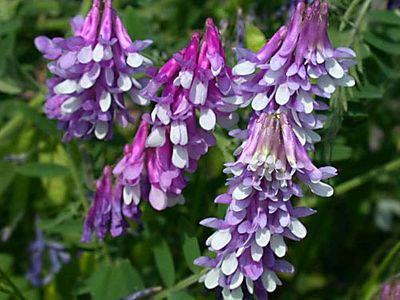Johnson's Home & Garden
We're Not Your Typical Store! Locally Owned and Operated Established 1995Welcome to Johnson's Home & Garden
Product Description

Hairy Vetch Food Plots
Hairy vetch provides wildlife cover and forage in the first year. Excellent for attracting deer in the daytime. Seedpods burst open when ripe. Quail and dove will consume seeds and foliage, while deer, turkey and rabbits eat the vines and leaves.
Type: A cool season reseeding annual legume
Uses: Hairy vetch makes an excellent addition to fall planted deer mixtures. Its spring forage production is very palatable to deer and turkeys and it makes an excellent seed crop for quail and turkey.
Planting Hairy Vetch For Food Plots
Plant early spring through summer after danger of frost on well prepared seedbed. Fertilization on an annual basis will keep the forage and seed rate higher.
Date: Sept. - Oct. Rate: 20 lbs./acre or ½ lb./1000 sq. ft. Depth: ½" maximum Best For: Deer, Turkey, Rabbit, and Quail
Short-term, legume green manure for nitrogen fixation.
Sow spring to late summer with or without grain, grass, or field peas. When sown late summer, spring regrowth is vigorous and nitrogen producing for tilling in before planting the spring garden crops. Typical nitrogen produced is 110 lbs./acre. This rapid spring growth also makes it a good weed suppressant. Hairy vetch prefers well-drained soils with a Ph of 6.0-7.0, and will do poorly in clay or wet fields. It will do well in soils too acidic for many clovers and alfalfas. May have some allopathic properties, so it is best to allow 2-3 weeks between incorporating and seeding of small-seeded crops. This selected hardy strain is widely adapted and withstands all but severe winters if sown in late summer or fall. Sow at 1 lb./1,000 sq.ft. (40 lb./acre) with rye or oats. Avg. 11,400 seeds/lb.
GROWING INFORMATION
Legumes
CULTURE: Sow the seeds at the time and rate specified for each variety listed. All legumes should be planted 1/4 to 1/2" deep. FOR GREEN MANURE: For best results, till under when in the flowering stage. SEED SPECS: Planting rates are listed with the variety copy. Organic systems should plant 1/3 to 1/2 heavier to allow for some weed pressures.
Hairy vetch provides wildlife cover and forage in the first year. Excellent for attracting deer in the daytime. Seedpods burst open when ripe. Quail and dove will consume seeds and foliage, while deer, turkey and rabbits eat the vines and leaves.
Type: A cool season reseeding annual legume
Uses: Hairy vetch makes an excellent addition to fall planted deer mixtures. Its spring forage production is very palatable to deer and turkeys and it makes an excellent seed crop for quail and turkey.
Planting Hairy Vetch For Food Plots
Plant early spring through summer after danger of frost on well prepared seedbed. Fertilization on an annual basis will keep the forage and seed rate higher.
Date: Sept. - Oct. Rate: 20 lbs./acre or ½ lb./1000 sq. ft. Depth: ½" maximum Best For: Deer, Turkey, Rabbit, and Quail
Short-term, legume green manure for nitrogen fixation.
Sow spring to late summer with or without grain, grass, or field peas. When sown late summer, spring regrowth is vigorous and nitrogen producing for tilling in before planting the spring garden crops. Typical nitrogen produced is 110 lbs./acre. This rapid spring growth also makes it a good weed suppressant. Hairy vetch prefers well-drained soils with a Ph of 6.0-7.0, and will do poorly in clay or wet fields. It will do well in soils too acidic for many clovers and alfalfas. May have some allopathic properties, so it is best to allow 2-3 weeks between incorporating and seeding of small-seeded crops. This selected hardy strain is widely adapted and withstands all but severe winters if sown in late summer or fall. Sow at 1 lb./1,000 sq.ft. (40 lb./acre) with rye or oats. Avg. 11,400 seeds/lb.
GROWING INFORMATION
Legumes
CULTURE: Sow the seeds at the time and rate specified for each variety listed. All legumes should be planted 1/4 to 1/2" deep. FOR GREEN MANURE: For best results, till under when in the flowering stage. SEED SPECS: Planting rates are listed with the variety copy. Organic systems should plant 1/3 to 1/2 heavier to allow for some weed pressures.



